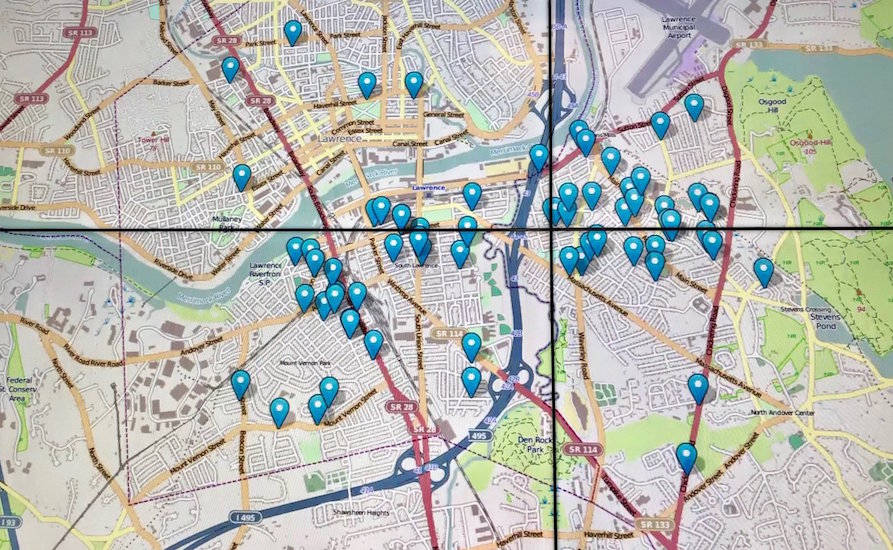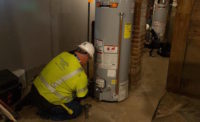A series of fierce gas explosions and fires rocked three towns north of Boston in the late afternoon on Sept. 13. Between 60 and 80 buildings were set ablaze by at least three explosions that forced the evacuation of more than 8,500 buildings in Lawrence, Andover and North Andover.
Approximately 25 people were treated for injuries, some of whom remained hospitalized early on Sept. 14, while one death was reported late on the day of the explosion. According to the Essex District Attorney's office, an 18-year-old man was sitting in his car in Lawrence when the chimney from a home that exploded landed on him.
By 11 a.m. on Friday morning, officials said all the fires had been put out overnight and 3,500 gas meters had been checked. Hundreds of gas technicians continued to go door to door to check meters throughout the day on Sept. 14.
"At this point all that we can say is that the investigation is in the preliminary stages and being conducted jointly between federal and state agencies," Kurt Schwartz, the director of the Massachusetts Emergency Management Agency, said during a mid-morning news conference on Sept. 14.
Gov. Charlie Baker's initial statement on Sept. 13 urged "residents to heed instructions from local officials for important public safety announcements, including evacuations and suspending gas usage."
First responders and firefighters from across the region poured into the area to fight what looked like "Armageddon," according to Andover Fire Chief Michael Mansfield. He told reporters that he suspected the explosions were caused by an overpressurized gas main.
Was Work Being Performed?
A press release on its website says Columbia Gas, which is owned by Indiana-based NiSource and serves about 50,000 customers in the area, had been upgrading its equipment in Massachusetts on Sept. 13. But Ken Stammen, a spokesman for NiSource, told ENR on Sept. 14 that he couldn't confirm that the company was performing work in the area before the explosion. He said the Sept. 13 release was part of a weekly batch of notices that the company posts about pipeline replacement projects. "We can't confirm there was any construction going on in that area," he said.
Accompanied by a police officer and a firefighter, Columbia employees went door-to-door throughout the night and morning to inspect and shut off gas lines. "Our thoughts are with everyone affected by today's incident," Columbia said in a statement. "We will continue to share information as it becomes available."
Just after 11 a.m. on Sept. 14, Columbia said in a separate statement that it had "More than 500 resources from several affiliated Columbia Gas companies and other utilities are currently mobilizing to provide assistance. … We are working with the appropriate authorities to investigate this incident."
The statement also said, "We are saddened to learn of the death of a young man as a result of these events."
In the initial hours after the explosion, U.S. Rep. Seth Moulton (D) decried Columbia's lack of communication. He tweeted, "Everyone wants answers. And we deserve them."
The Boston Globe reported that Columbia Gas Transmission Corp., a NiSource subsidiary before it was bought by TransCanada in 2015, was initially "slow to act" after a 2012 pipeline explosion in West Virginia. Federal officials ultimately issued the company three safety recommendations to the company and one to the Pipeline and Hazardous Materials Safety Administration, according to the Globe.
Baker said during a press conference at 12:35 a.m. on Sept. 14 that officials were still focused on public safety. "Once that's complete we'll work with the federal government and others to investigate how this occurred and to hold the appropriate parties accountable for their actions," Baker said. "I've made clear to the utility company that they must immediately bring in additional resources and develop a comprehensive safety inspection plan for each of these communities. The people of Lawrence, Andover and North Andover must be assured their homes are safe to return to and our local officials will make clear when it's safe to return home."
Officials said the earliest residents would be able to return home would be in the afternoon on Sept. 14.
Engineering Teams Dispatched
The U.S. Department of Transportation's Pipeline and Hazardous Materials Safety Administration and the National Transportation Safety Board sent teams of engineers and experts to investigate the scene.
Peter Goelz, the former managing director of NTSB, told New England Cable News that Thursday's gas line explosion was the largest he's seen since 2010, when a 30-in.-dia steel natural-gas pipeline in San Bruno, Calif., exploded. "Generally you see a single pipeline let go," Goelz told NECN, before adding, "something like this, that spread over that geography and affected so many structures, is quite extraordinary." He said the explosions "demand an extensive investigation."
Robert Sumwalt, the chairman for NTSB, addressed media in Washington, D.C., before heading to Massachusetts on Sept. 14. He said the agency will look into "the design of the pipeline system and any maintenance and upgrades in the process of being done. The NTSB's role is to conduct an accident investigation. We're there to investigate the accident to determine what happened so we can keep it from happening again."
This story was updated with new information at 2:50 p.m. on Sept. 14.






Post a comment to this article
Report Abusive Comment